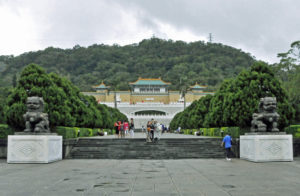
National Palace Museum in Taipei, Taiwan (Photo by Don Knebel)
Chinese nationalists overthrew the imperial Qing dynasty in 1911. In 1925, the nationalist government confiscated thousands of works of art and cultural artifacts that had been displayed in the palaces of the Qing and earlier dynasties. These items, from bronze and porcelain vessels from the earliest days of Chinese civilization to paintings and imperial government records, were eventually displayed at the Palace Museum in Beijing’s Forbidden City. In 1948, with the Communists threatening, the nationalists moved thousands of crates of objects from the Palace Museum and other important museums to Taiwan, then a Chinese province. When Chiang Kai-Shek and the nationalists retreated and proclaimed the Republic of China on Taiwan, they put the most important items on display in a newly established National Palace Museum in Taipei.
Taipei’s National Palace Museum now owns about 700,000 items, one percent of which are on display at a time. Among the most important items is Mao-Gong Ding, a 3,000-year-old bronze ceremonial caldron, famous for an encouraging message from the emperor to his governor inscribed in 500 ancient Chinese characters on the inside surface. Many visitors walk past the three-legged caldron and other items reflecting the extraordinary creativity and longevity of Chinese civilization, heading instead to the third floor. There they wait in line to file past a seven-inch-long cabbage head, carved in translucent jade, complete with a locust and a katydid. The intricately-carved green and white “Jadeite Cabbage” by an unknown sculptor was apparently given by a Qing emperor to his mistress in the late nineteenth century. It has become the most popular item in the museum’s vast collection.